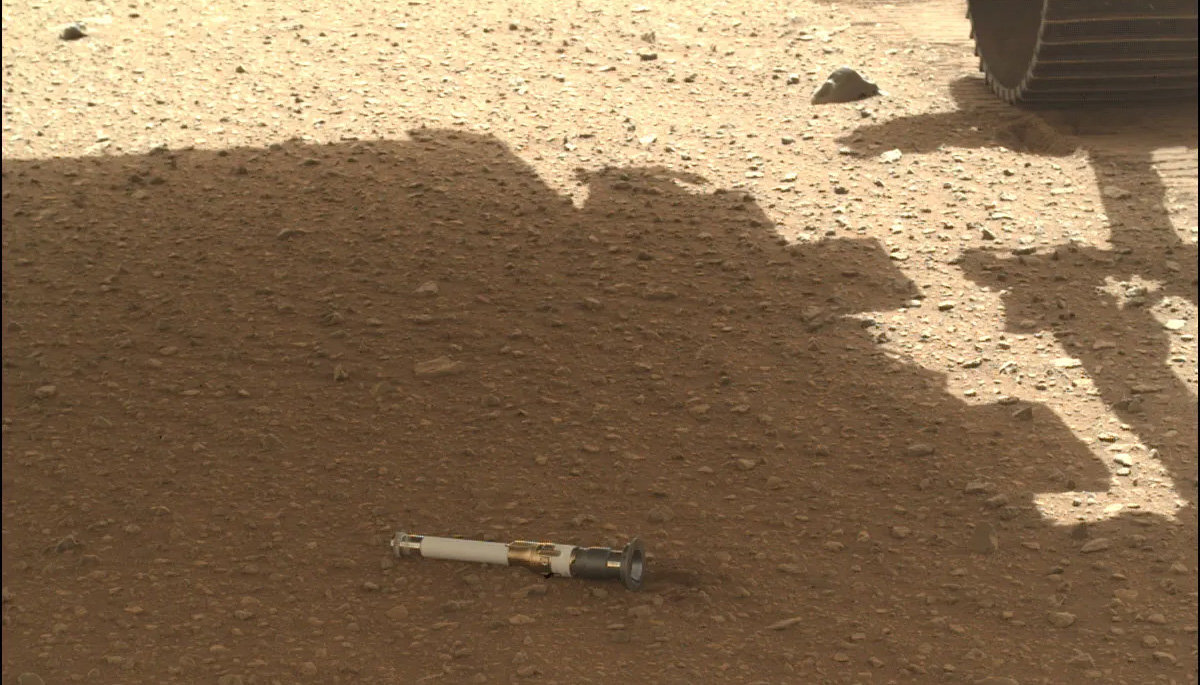Perseverance rover's Mars samples must be brought back to Earth, scientists stress
"These samples are the reason why our mission was flown."

Vital samples from a dried up lakebed on Mars could contain crucial evidence for past life on the Red Planet — but budget overruns are threatening the effort to bring those samples back to Earth, where researchers could actually tap into what secrets the specimens contain.
NASA's Perseverance rover, which has been exploring the ancient lakebed in Jezero crater since landing there in Feb. 2021, holds 43 sample tubes in which it continues to stash Martian material of scientific interest.
"These samples are the reason why our mission was flown," said planetary scientist David Shuster of the University of California, Berkeley, in a statement. Shuster is a member of NASA's science team for the collection and analysis of these samples.
However, while the rover's on board suite of instruments can provide a cursory analysis of the samples, the in-depth science necessary to investigate them can only be done back in a laboratory on Earth. For that to be possible, a mission has to go out to Mars, collect the samples from the rover, and bring them back. The plan was to launch that mission by the end of this decade and have those samples back on Earth by 2033. Yet, the cost of that sample-return mission, which is still in the design phase, began to skyrocket towards $11 billion, and the time to return those samples got pushed back to around 2040.
Related: Air sealed in Perseverance's Mars sample return tubes is as precious as the rocks themselves
So, earlier this year, NASA called a halt to those plans, and solicited ideas for new, cheaper and faster options from the private space industry. This has left the Mars science community in a bind, aware that a smaller-scale retrieval mission might not accomplish all the goals they had in mind — goals that were flagged by the National Academy of Sciences decadal survey as a top priority. Ten proposals are currently under consideration from companies such as Blue Origin, Lockheed Martin and Northrop Grumman.
The original mission blueprints were complex — land a Mars Ascent Vehicle (MAV) on the Martian surface, somehow get the sample tubes from Perseverance (perhaps using air-borne rotor-craft like Ingenuity), blast off the surface in the MAV (samples in hand) and rendezvous with another spacecraft, built by the European Space Agency, in Mars orbit that will bring the samples back to Earth. Yet, no matter how daunting such a mission sounds, it's essential for planetary science to be achieved with these Mars rock subjects.
Get the Space.com Newsletter
Breaking space news, the latest updates on rocket launches, skywatching events and more!
Now, a new research paper presents an initial analysis of some of the samples, conducted by the rover itself, to illustrate why exactly it is so vital that we bring the samples back to Earth. The research paper concerns itself with seven samples of sediment collected from the delta of the river that once flowed into the lake that filled Jezero 3.5 billion years ago. These samples, collected between July 7, 2022 and Nov. 29 2022, contain both fine- and coarse-grained sandstone and mudstone sediments.
"Sedimentary rocks are important because they were transported by water, deposited into a standing body of water and subsequently modified by chemistry that involved liquid water on the surface of Mars at some point in the past," said Shuster.

Coarse-grained sediments can tell us about the chemistry of the water that deposited them, because they contain both detritus and carbonate minerals that were washed from upstream.
It's the fine-grained sediments that will get most of the attention, however. That's because they are the type of sediment most likely to contain evidence of past microbial life on Mars, if it ever existed. "That's why these samples are so important," said Shuster.
The new report describes Perseverance's examination of the sampled materials. It did not detect organic materials, but Shuster isn't downhearted.
"We did not clearly observe organic compounds in these key samples," said Shuster. "But just because that instrument did not detect organic compounds does not mean that they are not in these samples. It just means they weren't at a concentration detectable by the rover instrumentation in those particular rocks."

That's why it is so important to get them back to Earth, where the most sophisticated laboratories can dissect the samples, learn their chemistry and find out what was really happening on Mars all those years ago.
"When we bring them back to Earth, they can tell us so much about when, why and for how long Mars contained liquid water, and whether some organic, prebiotic and potentially even biological evolution may have taken place on that planet," added Tanja Bosak, who is a geobiologist from the Massachusetts Institute of Technology, and the lead author of the new study.
So far, Perseverance has collected 25 samples, including duplicates and atmospheric samples, plus three "witness" tubes that contain examples of any possible contaminants from the rover. Eight of the duplicate samples were cached at a location known as Three Forks, where they were left on the surface by the rover as a back-up should something prevent Perseverance from handing over its stash to the sample-return mission. The other samples taken so far are of igneous rock probably created when Jezero crater was excavated by the impact that formed it 4 billion years ago.
Thus, the potential importance of the samples cannot be downplayed, as the new study team emphasizes.
"Life was doing its thing on Earth at that point in time, 3.5 billion years ago," said Ken Farley, who is the rover's project scientist at Caltech. "The basic question is, was life also doing its thing on Mars at that point in time?"
Once we get the samples back to Earth, we may finally be able to answer that question, but given the difficulties of achieving such a retrieval mission, perhaps it is best not to rush but to do the mission properly, even if it does cost more and take longer. The samples have been waiting on Mars, resting, for 3.5 billion years. They'll be able to wait a few more years until we are ready to go and get them.
The analysis of the river delta deposits was published on Aug. 14 in the American Geophysical Union's journal AGU Advances.
Join our Space Forums to keep talking space on the latest missions, night sky and more! And if you have a news tip, correction or comment, let us know at: community@space.com.

Keith Cooper is a freelance science journalist and editor in the United Kingdom, and has a degree in physics and astrophysics from the University of Manchester. He's the author of "The Contact Paradox: Challenging Our Assumptions in the Search for Extraterrestrial Intelligence" (Bloomsbury Sigma, 2020) and has written articles on astronomy, space, physics and astrobiology for a multitude of magazines and websites.
-
Broadlands This lengthly search for life on Mars has gotten way too expensive. To date there has been no evidence of any cellular remnants of microbial life. Sandstones and silts, but no laminated shale or slate rocks where organic carbon would most likely be found. No organic carbon fossils such as those found in the oldest rocks on Earth. So...until a rover finds any such evidence, going back to pick up a few rocks (no shales?) that hopefully "might" have some cellular carbon in them is very expensive wishful thinking. Time to "cut bait".Reply -
lewac Why? Nothing organic there and probably never has been. And so what IF there is? We have a LOT more problems here on our home planet (where we evolved) than on some rock where we cannot possibly survive.Reply -
Broadlands Reply
The Mars program has now basically become a make-work program for all those who would be out of work if NASA didn't keep looking for life. Finding that billions of years ago Mars could have been habitable is all that they could legitimately conclude. So wasting money going back to pick up some rocks and then draw the same conclusions is completely unwarranted. Follow the money?lewac said:Why? Nothing organic there and probably never has been. And so what IF there is? We have a LOT more problems here on our home planet (where we evolved) than on some rock where we cannot possibly survive. -
Unclear Engineer I'll post a disagreement with the first 4, here.Reply
The amount of money spent on getting rocks back from Mars is paltry compared to the amount of money just the people in the U.S. spend on recreational and entertainment activities.
Arguing that we should stop scientific research to "support the poor" (or whatever charitable acts posters envision) seems rather silly when a tax on "wasteful spending" by individuals would raise more money for such "good causes".
So, just think of science projects as "entertainment for scientists" the next time you look up from your expensive video game and decide to say that scientists are wasting money trying to understand something that is real, rather than just playing with fictional stuff in games. After all, you would not even have video games if there had not be science projects that led to the understanding of many physical principles needed to make them. -
Broadlands Reply
Whoa.. " and decide to say that scientists are wasting money trying to understand something that is real."That's the whole point.. they have been spending years (and giga$$$$) trying to find out if life on Mars was real...actually there. And have come up with a blank. This is not a video game. It's real-life spending...time and money.Unclear Engineer said:I'll post a disagreement with the first 4, here.
The amount of money spent on getting rocks back from Mars is paltry compared to the amount of money just the people in the U.S. spend on recreational and entertainment activities.
Arguing that we should stop scientific research to "support the poor" (or whatever charitable acts posters envision) seems rather silly when a tax on "wasteful spending" by individuals would raise more money for such "good causes".
So, just think of science projects as "entertainment for scientists" the next time you look up from your expensive video game and decide to say that scientists are wasting money trying to understand something that is real, rather than just playing with fictional stuff in games. After all, you would not even have video games if there had not be science projects that led to the understanding of many physical principles needed to make them. -
Unclear Engineer Broadlands, you seem to have missed the point entirely.Reply
Science tries to answer real questions. Video games do not. Finding out if life really occurred on Mars provides some knowledge, whether the result is positive or negative. Playing a video game provides no knowledge. Stopping the process of studying Mars before it is completed would be the only outcome that would make the mission a failure. Arguing that it has already failed because it is not yet complete is a specious argument.
On the other hand, I do agree that costs seem to be getting out of control with too many of the contractors that we have been using. Comparison of the Boeing capsule to the SpaceX capsule is the best current example of too much financial waste and not enough scientific progress to show for it. -
Classical Motion Reasoning…… the concept of comparison manipulated by the concept of equivalence.Reply
Reasoning might turn out to be unique and singular.
8 billion singularities.
Maybe a scale/norm can not be set.
Water heater busted last night. What a mess.
A new one by 6 this evening, so they tell me. $450 for new tank and $1318 for install and removal.
And I was told that was a reasonable price.
But it seems very singular to me. -
Broadlands Reply
The original question was real. "Is there life on Mars?" But now it's not about life but all about habitability billions of years ago because they have found zero evidence of any cellular carbon at all. Bringing back a few essentially randomly selected rocks will not change that. The odds are strongly against it. They haven 't even seen, much less selected any dark shales or black slates where organic carbon residues would most likely be found. Sandstones and silts are notoriously bad for finding organic matter residues. The mission is not a failure in many other respects. But, going back to retrieve a few samples will make it one, even if they found a minuscule piece of carbon. What then?Unclear Engineer said:Broadlands, you seem to have missed the point entirely.
Science tries to answer real questions. Video games do not. Finding out if life really occurred on Mars provides some knowledge, whether the result is positive or negative. Playing a video game provides no knowledge. Stopping the process of studying Mars before it is completed would be the only outcome that would make the mission a failure. Arguing that it has already failed because it is not yet complete is a specious argument.
On the other hand, I do agree that costs seem to be getting out of control with too many of the contractors that we have been using. Comparison of the Boeing capsule to the SpaceX capsule is the best current example of too much financial waste and not enough scientific progress to show for it. -
Unclear Engineer I have made my points and am not going to continue arguing with 3 new posters who have only a few posts to this forum. It looks to me like those posts are part of an influence campaign that will continue to post illogic because that is the mission, no matter what else is posted. I think you guys are going to have a hard sell to the participants in this forum, no matter what your motives. The people who frequent this site are interested in questions about how the Earth formed, how life began, etc. Calling that interest "wasteful" is not accepted logic. You would have to come up with a better, cheaper way to get the information, which you have not attempted. The Mars and other robotic explorers are already the type that some here tout as the most cost-effective way to study other planets, compared to human crewed missions.Reply









